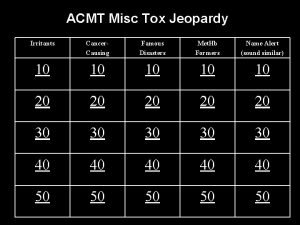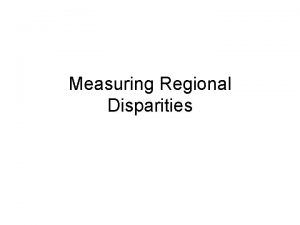Cancer disparities Faina Linkov Ph D Univerisity of





















- Slides: 21

Cancer disparities Faina Linkov, Ph. D Univerisity of Pittsburgh Cancer Institute

Cancer Disparities: Definition The NCI defines "cancer health disparities" as "differences in the incidence, prevalence, mortality, and burden of cancer and related adverse health conditions that exist among specific populations groups in the United States. "

True of false? Disparities exist only because of poverty

True of false? Most disparities have genetic basis

True of false? Minority groups in most countries have poorer health outcomes

True of false? Minority groups in various countries around the world countries have poorer health outcomes

Burden of Cancer in U. S. Seven Strategic NCI Priorities § Reducing Cancer Health Disparities § Integrated Clinical Trials System § Advanced Technologies § Molecular Epidemiology § Integrative Cancer Biology § Strategic Development of Cancer Interventions § Prevention, Early Detection and Prediction

The anatomy of disparity § Death from Preventable cancers § Death from late-stage cancers otherwise detectable § Sub-standard treatment and care for minority groups § Death from curable cancers § Absence of pain control, other palliative care for cancers that do not have cure

What is the cause of cancer disparities?

Some of the reasons v Genetic? Big question v Nutrition & Physical Activity v Tobacco use v Viruses (Hepatitis B, HPV) v Lack of early-detection v Lack of timely and aggressive treatment v Access to care v Many, many others…

Table 1. Overall Cancer Incidence and Death Rates All Sites Incidence Death 470. 1 192. 7 African 504. 1 American/Black 238. 8 Asian/Pacific Islander 314. 9 115. 5 Hispanic/Latino American Indian/Alaska Native White 356. 0 297. 6 129. 1 160. 4 477. 5 190. 7 Racial/Ethnic Group All

Obesity and Common Cancers v Women § Endometrial, ovarian, colon, breast (postmenopausal), renal cell v Men § Colon, prostate v Possible Mechanisms: § Hyperinsulinemia (especially central adiposity) associated with cell growth & proliferation § Adipose tissue is primary source of estrogens, which has been linked to carcinogenesis

Dietary components and risk of common cancers Cancer Increase Risk Decrease Risk Breast Alcohol, excess energy intake, weight gain Vegetables, monounsaturated fats Colon Red meat Fruit/vegetable fiber, Alcohol Vegetables, especially green/yellow Lung Prostate Meat Lycopene (tomatoes) GI Alcohol, Sodium Fruit/vegetables

Physical Activity and risk of common cancers Cancer risk Breast inconsistent association—time period may be critical Colon 30 -40% decreased risk among active men & women (Rectal—no association) Prostate findings inconclusive Possible mechanisms: 1. Decreased GI transit time which decreases carcinogen exposure) 2. Enhanced immune function with moderate PA 3. Lowered levels of reproductive hormones

Hispanics … Highest cervical cancer incidence rates: § Highest cervical cancer rates § 15. 8 per 100, 000 Hispanic females § Almost twice the incidence rate of white females

African Americans Highest prostate cancer mortality rates: § 68. 1 deaths per 100, 000 black men § More than twice the rate of whites and nearly three times the rate of Hispanics

Asian Americans/Pacific Islanders … Highest incidence rates of liver and stomach cancers for both genders § 14. 0 per 100, 000 for liver and bile duct cancer– more than twice as high as any other population group § 15. 9 per 100, 000 for stomach cancer, which is twice the incidence rate for whites

American Indians/Alaska Natives § Third highest lung and bronchus death rates among women – 27. 1 deaths per 100, 000 females, nearly twice the rate of Hispanic/Latinas

Burden of Cancer in U. S. Overall Cancer Disparities CANCER INCIDENCE Hispanics/Latinos 352. 4 512. 3 335. 6 233. 6 African Americans Asian Americans/Pacific Islanders American Indians/Alaska Natives 479. 7 Whites Source: Surveillance, Epidemiology and End-Results Users Program, 2002. Numbers per 100, 000 persons

Burden of Cancer in U. S. Overall Cancer Disparities CANCER MORTALITY Hispanics/Latinos 135. 2 248. 1 132. 4 African Americans Asian Americans/Pacific Islanders American Indians/Alaska Natives 119. 9 195. 3 Whites Source: Surveillance, Epidemiology and End-Results Users Program, 2002. Numbers per 100, 000 persons

What makes these population groups different • Different levels of infection with h. pylori and hpv • Differential access to care • Genetics • Insurance coverage • SES
 Faina linkov
Faina linkov Faina linkov
Faina linkov Loris faina
Loris faina Chapter 3 health wellness and health disparities
Chapter 3 health wellness and health disparities Health disparities meaning
Health disparities meaning Maternal and infant health disparities
Maternal and infant health disparities Health disparities meaning
Health disparities meaning 30-30-30 model of health disparities
30-30-30 model of health disparities 30-30-30 model of health disparities
30-30-30 model of health disparities Hur stor skarns är det för ett barn att få cancer
Hur stor skarns är det för ett barn att få cancer Ovarian cancer brca
Ovarian cancer brca Pes statement for cancer
Pes statement for cancer Conclusion of breast self examination
Conclusion of breast self examination Breast cancer reconstruction forum
Breast cancer reconstruction forum Tropic of cancer 23 1/2
Tropic of cancer 23 1/2 Guardian cancer policy
Guardian cancer policy Phenylenediamine cancer
Phenylenediamine cancer Dephosphorylation
Dephosphorylation National breast and cervical cancer early detection program
National breast and cervical cancer early detection program T2g3 bladder cancer
T2g3 bladder cancer Portacath
Portacath Colon cancer pathway
Colon cancer pathway






































